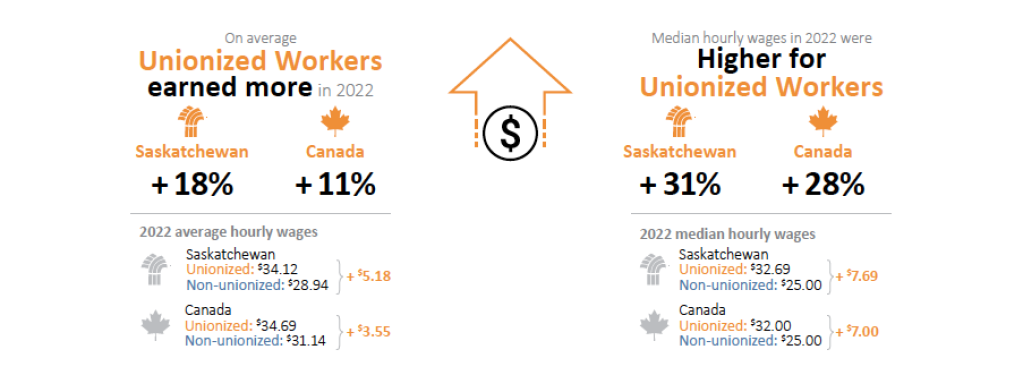This holiday season, let’s think of the gift that keeps on giving: unions!
From average wage advantages to supplemental benefits, collective bargaining gets the goods. Unionization in Saskatchewan and across Canada continues to deliver material gains for workers by way of higher wages and access to supplementary benefits like health insurance and pensions. This is worth talking about in the context of what appears to be trend in union revitalization throughout North America. We could say that unions are back in the news, and for good reason.
South of the border, the United Autoworkers (UAW) engaged in a historic contract fight and strike against the “big three” auto manufacturers—some of the wealthiest corporations on the planet. Union members engaged in a level of militancy not seen in the US auto sector for decades, taking aim at two-tier contracts, as well as other concessions that unions yielded to the industry following the 2008 financial crisis. This comes after an internal uprising of UAW members sought to democratize the union and oust corrupt old-guard leaders.
Hollywood writers and actors have mobilized and went on strike as well—against the ways artificial intelligence poses a risk to creative and cultural workers across industries and economies.
These unions are fighting business models that are hungry for profits at the expense of labour. Similar battles are being waged here at home.
Unifor faced off against auto giants in Canada, but with fewer demands than their counterparts in the U.S. Strikes in the country’s ports, construction industry, retail, sugar refineries, and public sector are putting workers in a position to secure fair wages as the cost of living is skyrocketing. The Bank of Canada’s solution—hiking interest rates—is making matters worse for workers, so don’t count on monetary policy to bring relief for average people.
Classroom sizes and working conditions pressed Saskatchewan teachers to vote overwhelming in favour of job action—or as they called it, “sanctions”—just as the provincial government attempts to pit the public against educators. As a constitutionally protected right following the Supreme Court’s 2015 SFL decision, strikes are awakening Canada’s labour movement.
We’re also witnessing a resurgence in organizing initiatives, marked by successful efforts spearheaded by Starbucks baristas and Amazon distribution centre workers to secure collective bargaining rights.
Recent polls suggest that Canadians are on side with unions. Three in five believe that organized labour has a positive impact for those it represents, according to a September 2023 Angus Reid survey. A similar percentage of members are satisfied with the representation they receive, despite concerns about the value of dues. Most of the country believes that the right to strike outweighs the consequences, with the exception of Saskatchewan, which was once a beachhead for progressive labour politics—a legacy that is quickly receding thanks to a sharp rightward tendency since at least 2007 with the election of the Sask Party.

Popular opinion also tells us that support for union organizing exceeds the actual union density rate across Canada. Young workers in particular are keen to win collective bargaining rights. Union leaders should take note.
Unionization continues to deliver material gains for workers by way of higher wages and access to supplementary benefits like health insurance and pensions. Around 80 per cent of unionized workers possess paid sick leave of some sort, versus 55 per cent of non-unionized workers in Canada. COVID-19 exposed the importance of these kind of leave provisions.
Workers who are covered by collective agreement also come out on top by securing paid vacation time and supplemental parental benefits at higher rates than the non-unionized labour force. Across the board, unionized workers earn on average 11 per cent more per hour than their non-unionized counterparts—18 per cent in Saskatchewan, where enthusiasm for unions is waning more than any other province.

Unionized accommodation and food service workers are far more likely to possess paid vacation, supplemental health care, sick leave, and pensions than non-unionized employees, despite the relatively low union density rate in the industry at seven per cent. Even though wages are generally comparable, unionization brings important supplemental benefits to otherwise precarious workers. These advantages apply to higher paid and skilled occupations in industries, like Finance or health care and social assistance.
Women and young people benefit the most, which might help explain why these two demographics are the strongest supporters of unionization according to polls. The strongest gendered wage advantage is in education, where women earn $7.35 more per hour than their non-unionized colleagues. In accommodation and food services, where employers complain about the absence of suitable workers, young people also experience a union wage premium—both for full and part-time workers. In construction, unions mitigate the gender wage gap between women and men. In other male-dominated industries, like manufacturing, the union advantage is narrowing. That raises serious political concerns, and helps to account for why men have a lower opinion of unions than the general population.
Unions in Canada continue to deliver the goods—despite stagnant density rates and decades of austerity. Assaults on collective bargaining, the right to strike, and efforts to unionize have not undermined the capacity of labour to bargain its fair share, even at a time when central banks and economic circumstances are making life harder for the working class.
Young workers, in particular, are noticing—but, by themselves, these benefits don’t translate into better agreements or growing certification rates. That takes resources and a commitment by union leaders to mobilize existing members, and most importantly to organize the unorganized. After a prolonged drought of activity, unions in Canada and in the United States are starting to demand what was taken from them after years of concessionary bargaining.
Dr. Andrew Stevens and Angèle Poirier have co-authored a report published by the University of Regina, The Union Advantage: A Comparison of Union and Non-Unionized Wages in Canada and Saskatchewan (November, 2023). The report can be found on-line. Andrew can be reached at Andrew.stevens@uregina.ca







